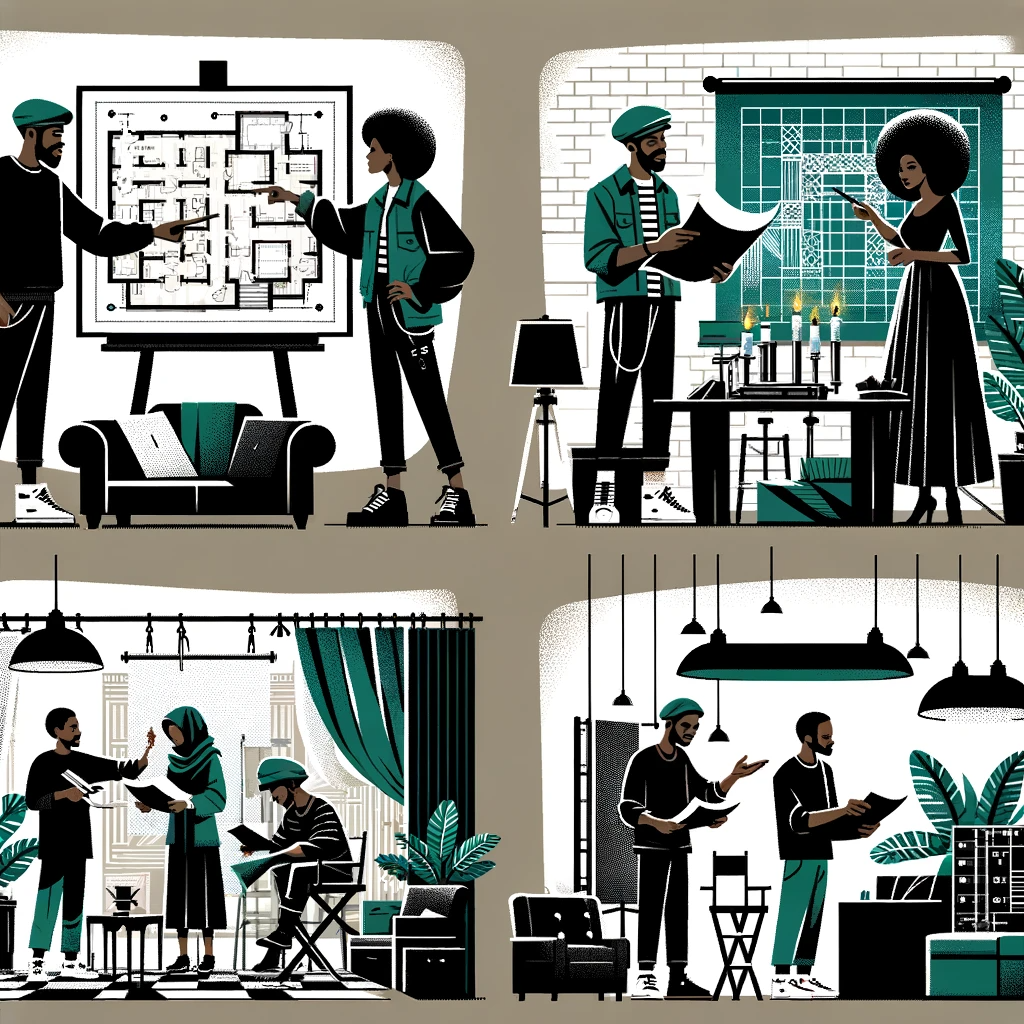Table of Contents
When a Nigerian film grabs your attention with stunning visuals, rich detail, and vibrant spaces—it’s not by accident. It’s the result of thoughtful art direction, where vision meets craftsmanship. Art direction is the bridge between a film’s script and its visual world. It transforms words into locations, sets, and atmospheres that make a story feel real.
In Nollywood, art direction does more than decorate a scene—it reflects culture, emotion, and identity. This guide explores what art directors do, how their work unfolds from script to set, and why their contribution is essential to Nigerian cinema.
What Does an Art Director Do?
An art director is responsible for creating the physical environment of a film. They design the visual tone of each space, making sure it aligns with the story, the characters, and the director’s vision. Working alongside the production designer, they:
- Interpret the script and imagine each location
- Design sets, source props, and modify real-world locations
- Supervise set construction and decoration
- Collaborate with costume, lighting, and cinematography teams
In short, the art director helps audiences believe in the world on screen.
Art Direction vs. Production Design
Though often used interchangeably, these roles are distinct:
- Production Designer: Develops the film’s overall visual concept—including colors, themes, costumes, and environments.
- Art Director: Executes the production designer’s vision. Focuses on the logistics, builds, and details of physical spaces.
Both roles work closely with the director and cinematographer to maintain visual consistency.
Art Direction in Nollywood: Then and Now
In the early home-video era, Nollywood relied heavily on real locations—family houses, offices, hotels. Art direction was minimal, and improvisation was key.
But things have changed. As Nigerian films grow in ambition and budgets, so does the role of the art department. Now, art directors:
- Build entire fictional worlds (palaces, markets, future cities)
- Use color and design to express character and culture
- Solve creative problems with limited resources
Films like “Christmas in Lagos,” “Suky,” and “Breath of Life“ show how rich, purposeful art direction can elevate a story.

How Culture Shapes Nollywood’s Visual Language
Nigerian art directors pull deeply from local heritage. Their work often blends:
- Traditional architecture (mud walls, wooden gates, compound layouts)
- Textiles and patterns from Yoruba, Igbo, Hausa, and other cultures
- Handmade props like calabashes, stools, masks, or sculptures
- Color symbolism (reds, yellows, earth tones) rooted in tradition
This cultural depth gives Nollywood its unique visual identity—and helps it resonate globally.
The Art Director’s Creative Process
From script to screen, art direction follows a clear but collaborative path:
1. Script Breakdown
- Identify all sets, props, and visual environments
- Highlight story moments that need unique designs
2. Concept Development
- Mood boards, sketches, and 3D visualizations are created
- Color palettes and textures are explored
3. Location Scouting
- Real-world spaces are found or modified for the story
- Consider light, space, access, and transformation potential
4. Set Construction
- Carpenters, painters, and designers bring sketches to life
- Everything is tested for camera movement and actor blocking
5. Set Dressing & Props
- Props are carefully chosen or custom-made
- Each item adds cultural or emotional meaning to the space
Major Responsibilities of Nollywood Art Departments
- Set Design: Designing rooms, streets, or imagined worlds that support camera angles and character blocking.
- Set Decoration: Choosing and placing furniture, fabrics, wall art, signage, and other details.
- Prop Curation: Selecting objects that tell the story—books, phones, weapons, or sacred items.
- Location Transformation: Dressing up existing spaces to become something entirely new.
Art direction is about more than beauty—it’s about meaning.
Challenges Facing Nollywood Art Directors
Even with creativity, the job isn’t easy. Common challenges include:
- Low Budgets: Reusing props or relying on DIY tricks to stretch resources
- Tight Schedules: Limited time for building and dressing sets
- Limited Access: Difficulty finding culturally specific props or design materials
But Nollywood’s art directors are masters of resourcefulness. They repurpose, repaint, and redesign with speed and flair—keeping the story at the center.
Final Thoughts: The Story Lives in the Details
Art direction isn’t just about making things look good. It’s about building a visual language that reflects a story’s heart.
For Nigerian filmmakers and aspiring creatives, the art department is a place of bold creativity, cultural pride, and design innovation.
Because when the world looks at Nollywood, what they see first—is what the art department imagined.

















Leave a comment